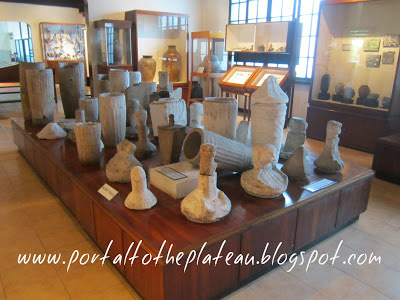Of course, I didn’t let the opportunity to see the jars pass. On November 5, Monday, I dropped by the University of San Carlos Museum, and for the first time, I was able to see the actual jars, not just their online photos. I even ran my fingers along their ridges. It was a surreal experience. I found myself on the verge of tears.
The jars were displayed atop a knee-high wooden platform about two meters wide and four meters long. The platform was placed right in the center of the museum, which was about the size of three classrooms joined at the sides. Thus I can say that the burial jars from Kulaman are the most prominently featured, and maybe the most valuable, artifacts in the museum.
After my extensive online research, I thought I had become a connoisseur of sorts of the jars. I was taken aback when I could not properly classify the artifacts in front of me. I tried my best, though, and I came up with an inventory of burial jars in USC’s possession.
I counted thirty-seven items in all, but only two of them were complete. One was medium-sized, circular, and nearly immaculate. Its body had bold diagonal ridges, and its cover was in the shape of a tent. Carved on the cover were two figures of lizardlike men. The figures were placed back-to-back, on the two wider sides of the cover.
Another complete item was a small quadrilateral jar that appeared grimy. It had dark yellow streaks around it. Its simple flat cover had a protruding knob. At first I thought the design was phallic, but on closer inspection, I found out that tiny holes had been bored on the knob to make it appear like a human face.
Including the two complete ones, there were eighteen jars altogether. The rest of the thirty-seven items were mostly anthropomorphic lids and some fragments I could not identify. Of the eighteen jars, only three were quadrilateral; the others were circular. Two were more than one meter high. Most had simple vertical or diagonal ridges around their bodies, but one of the tallest had a carved figure of a man.
The jars, or at least the ones that didn’t have covers, were empty, so there were no Late Neolithic human bones to see. The collection, though, also had some pieces that were discovered with the jars. They were tacked on a board near the wall, and they included stones, shells, and boars’ teeth.






